
Thursday 25th January We fly to the Galapagos.
It was a grey and humid morning as we were driven the short distance to the airport. We said goodbye to our driver Galo, who had done such a good job driving down from the hills yesterday in the fog and the rain.
Diego told us of the sad news that Ecuador’s new defence minister had been killed in a helicopter crash along with her 17 year old daughter at Manta, a town on the coast.
Conscientious to the last, Diego helped us through all the formalities, so we had time to look in at the few shops – I bought a tiny brooch of 2 tiny Ecuadorian figures.
We said our goodbyes to Diego, everyone with heartfelt thanks. Now we were on our own.
Our plane actually took of a few minutes early. We were able to see vast stretches of water around Guayaquil, before we went into cloud, which stayed for almost all the way.
We were served a snack meal, and were soon landing at Baltra airport in the Galapagos. The flight had taken 1½ hours and it was now 12.45 local time (1.45 to us). Everywhere looked very dry. We were told that the temperature was 28ºC. I saw a frigate bird as we landed, and we were soon to see many more.
Baltra airport, an old World War 2 US Military airport, is on its own island, so after a bus ride across this island, we had a short ferry ride to Santa Cruz Island, seeing several brown pelicans, and then a 45 minute bus journey to the south of the island. Doug was amusing us by trying to tell us what we were seeing, as Diego had done. We passed through a variety of vegetation. At first there were trees with bright green leaves, growing from the large rocks of the ground. Later the vegetation became very lush and green. There were lots of trees with brilliant orange red flowers, and others with bright yellow flowers.
We reached Puerto Ayora, a pleasant looking little town, and met Nadine, our guide for this part of the trip. She was a small, sprightly lady, with dark hair and skin, reminding us of Jeannie Ruhl.
As we waited for the inflatable craft to take us out to our boat, we watched Sally lightfoot crabs in the water, a small marine iguana and a night heron. Pelicans and blue footed boobies were diving for fish, of which many were clearly visible.
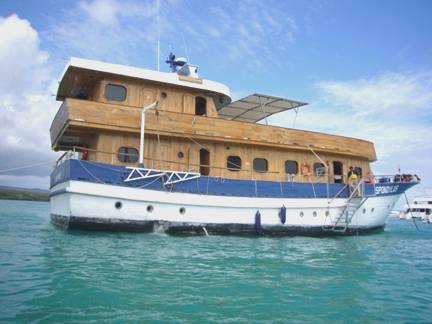
Spondylus – our home for a week
We saw larger marine iguanas when we reached our boat, the Spondylus. The ‘girls’ were taken to the boat first, as 2 journeys were needed. We were directed to our cabin, which I was pleased to see was above deck. There were 2 cabin beds, but we didn’t have time to do anything, as it was back on deck for lunch, after we had had a demonstration on using the life jackets. This included the youngest crew member leaping into the water, fully clothed!
There was no time to hang around! It was off again – dinghy first, then a 45 minute bus journey back to the ‘highlands’ to see the giant tortoises. After the village of Santa Rosa, we turned off on a muddy track. After 5 years of drought, there had been 10 days of rainy weather here. We had a short heavy shower just after we reached the reserve where we were going to see the tortoises. Luckily it remained relatively dry for our walk around, but we needed the wellies which were provided, as the ground was very muddy and slippery.
The first tortoise we saw was lying in a small pond, with 2 white-cheeked pintails behind it. Several other birds were flying around. We moved on to see 2 tortoises mating. The male was at least twice the size of the female, and mating apparently lasts for 3 hours! While we were there, the male moved off, and later the female ran swiftly away, with the male in hot pursuit!

Giant tortoises mating
We were driven a short distance back along the track, where we walked down into a huge lava tunnel – a superb specimen, much larger and longer than those we saw in Hawaii.
It was really misty as we were driven back to Puerto Ayora, and when we reached there it was dark. Back on the boat, it was time for supper, followed by a briefing about tomorrow’s activities. Only then did we have time to come back to or cabin to sort out all our gear – it had been a long day!
Friday 26th January Exploring Floreana Island
We travelled overnight to Floreana Island. Before visiting the island, we had to be fitted out with our snorkelling gear. Then we left, in the dinghy, for a ‘wet landing’ on to the sandy beach.
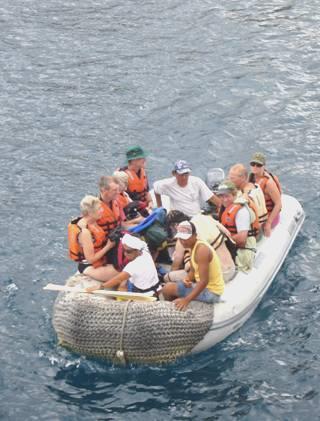
Heading for the shore
We were at Punta Cormorant (there are no cormorants here), and walked across to the lagoon, where we saw lots of greater flamingos, and a black necked stilt.
We had seen blue footed boobies on the way to land, and more sally lightfoot crabs. We walked across to another beach, where we saw green turtles, sea lions, stingrays and a yellow crowned night heron.
Back at the first beach, we saw a pencil sea urchin. Then it was time for us to snorkel, and we saw more sea urchins, both pencil and green ones, as well as dozens of different types of fish. I was really excited to sea a huge shoal of fish – literally thousands of them. They were greyish, with large black eyes edged with yellow, and they shimmered silver when they turned. Adrian saw more stingrays. On the beach were sea lions and a marine iguana.
Back on board, it was time for lunch, and we were well ready for it!
After that came a lazing around time, which I found a bit tedious until we decided to edit some of the photos.
At 3.30 we were off again – the boat had moved along a bit, and now it was time for us to visit Post Office bay. This is where, in 1793, British navigators left a wooden barrel for sailors to leave their home-going mail in. The original barrel has long since gone, but there is still a barrel, and the idea is that you leave a postcard there, and take one which is addressed near to your home, and deliver it, either by hand, or by post. We sorted through the cards, and found one addressed to Wilson Road, Reading – where Adrian started his secondary education! It had only been left there today, so we took it, of course, and hope that someone will take the one which we left.

Leaving our postcard at Post office bay
The sun was very warm as we continued on a little path up the hill, seeing the site where Norwegians had set up a short-lived cannery, and where other people had once made their home. Without any fresh water, living on the islands has always been difficult. About 100 people live on this island now.
The track ended at the mouth of a cave, caused by a lava flow – another lava tube. There were 2 sets of rickety stairs down into it, and Barry climbed down, but the caves were very low, so even he didn’t get very far.
Back on the beach, it was time for another delightful snorkel. We saw myriads of different fish, hundreds of tiny purple sea urchins, and Adrian saw a sea lion. Turtles were bobbing their heads out of the water as we left.
A shower refreshed us, then we watched the sun go down, and enjoyed a rum and coke. At the briefing we were told of a 5.00 am start tomorrow! We were then given a pleasant cocktail, and introduced to the crew.
After supper we began sailing again, and it started to rain. We saw swallow-tailed gulls above us – the only nocturnal gulls.
Saturday 27th January Wildlife on Espanola and snorkelling with a sea lion and a shark
We were up at 5.00 am and soon having breakfast. It had been a really rough night, but the major problem for us was the heat, as our cabin is situated above the engine room, and the air conditioning doesn’t work, so that we were both dripping with sweat continually. Janet had been very unwell during the night, so she and Roger stayed behind when we went on our trip at Punta Suarez on Espanola (Hood) Island. Mary also didn’t come, as there are no toilet facilities on the island, and going ‘al fresco’ isn’t allowed.
The rest of us had the best trail of the trip so far. The going was pretty rough – over constant large, angular rocks, but the wild life we saw was great.
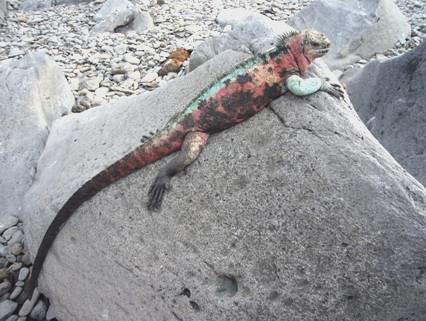
A colourful marine iguana on Espanola
Young sea lions were cavorting in the waves, while adults were strewn everywhere. Sally lightfoot crabs abounded, as did marine iguanas – often looking dead in their stationary positions.

A Sally lightfoot crab scuttles off
We saw the swallow-tailed gulls which we had seen last night, with their bright red eye ring.
Most attractive were the blue footed boobies, which were here in their hundreds. We were able to observe all stages of their courtship display, including the dancing feet and the raised wings.
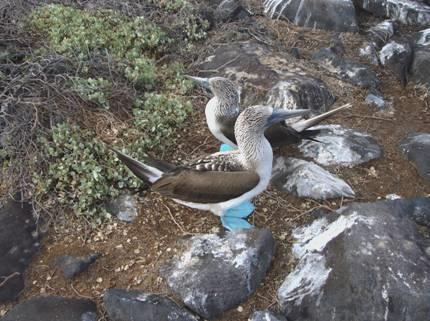
Blue footed boobies performing their mating ritual
Nazca boobies also had colonies here, and were good to watch.
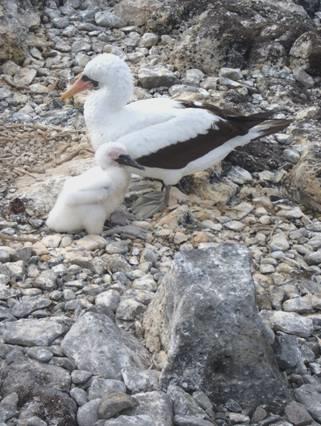
A Nazca booby with its chick
We were sorry that the waved albatrosses had left recently, but we did see an abandoned egg.
We saw mocking birds, the Galapagos dove, ground finches and tropicbirds. On a tree we could see a Galapagos hawk, and as we neared the end of the trail we saw a whimbrel and a pair of oystercatchers with the female sitting on the nest.
To add to the photos, it was an attractive island, with a good blow hole.
We returned to the boat at about 9.30 am.
As the boat continued the short way to Gardner Bay, we saw short finned pilot whales cavorting out to sea. We soon came to anchor offshore from Gardner Bay, which looked beautiful with its glowing white sand and the turquoise sea. Now it was time for our ‘deep water snorkelling’. A group of us set off in the dinghy, with Nadine as leader. We swam from the dinghy, for what turned out to be a long snorkel, right back to the boat. The rewards were great – all sorts of different species of fish, some in shoals, and I even saw one spawning, large dark sea urchins, and some ‘extra specials’ – a sea lion, a shark and a turtle! I wanted to cry out with excitement when I found the sea lion beside me. The experience was all tinged with a bit of nervous excitement, and when we reached the boat again, we were well ready for lunch!
In the afternoon we left in the dinghy to visit the beach. Just as we arrived at the beach, the drizzle began. This was a shame, as the situation was so lovely. There were sea lions everywhere, and we watched them as we walked along the beach. There were mothers with babies, young ones, and the dominant males. We were able to see two sea lions mating, and then swim out to sea. Instead of getting better, the rain just got harder. By the time we had returned to our gear, we were soaked to the skin. I decided that I might as well have a swim, and later some others followed, including Adrian eventually, and a sea lion initially!

Sea lions were always a joy to see
It was warm in the water, and soon the boat arrived to take us back. After having a shower, we went to the dining room, where there were warm nibbles for us. Before supper, the captain came and apologised for the weather, and the fact that the boat was leaking (some of the rain dripped right on to Adrian’s bed) and also that the air conditioning couldn’t be repaired. The boat is going into service for a month after this trip – which doesn’t help us!
He then said that drinks at the bar will be free for the rest of the trip, as compensation (but they soon ran out of wine)!
The boat was sailing for San Cristobel Island now, and Adrian was feeling a bit shaky. He did come and join us for supper. We soon arrived at Puerto Baquerizo Moreno on San Cristobel, and were treated to a firework display. The rain had now stopped, so we enjoyed staying on deck and chatting, looking out to the lights of the town.
Sunday 28th January More snorkelling and wildlife on Santa Fe
It was cooler with the door open, so we both slept better. After breakfast we left in the dinghy for Puerto Bacquerizo Moreno. First we visited the Interpretive Centre, quite a modern museum, which explained the formation of the Galagagos Islands and had information on its wildlife and history.

An opuntia cactus flower seen flowering on San Cristobel
We walked down into the small oceanside village, where we had just half and hour – not long enough! We went into an internet café and sent a short message to our kids. We both bought Galapagos T shirts, and I had a quick Galapagos coffee. Back on the boat, we sailed immediately for Santa FeIsland.
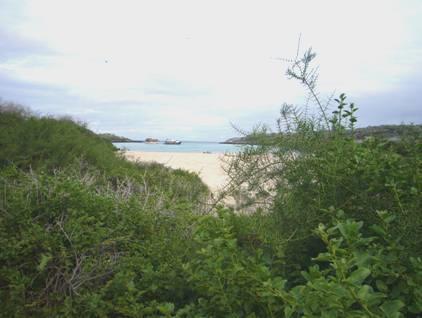
Anchored off Santa Fe Island
Once there, we anchored by the delightful turquoise bay with 2 sandy beaches separated by rocks. We’d had lunch, so almost as soon as we’d anchored, we set off for another wonderful snorkel, starting from the boat. As before, everything was a bit haphazard, and we weren’t sure where we were going. The viewings were great though – 3 manta rays, 2 sea lions, a turtle, and all sorts of wonderfully colourful fish.
Back on board, there was just time for a shower before we were off again to the island in the hope of seeing land iguanas. We had a mishap as we arrived at the beach, when Ron fell awkwardly when getting out of the dinghy. He wanted to carry on, but had twisted his knee, and even the help of both our hiking sticks wasn’t enough. He stumbled again on the rocky path, so had to return to the boat. We continued on this rough path, making a circle back to the second beach. There were lots of opuntia cactus – the older ones had smooth trunks which had lost all the spines.

A land iguana on Santa Fe
We did see what we’d come to see – several land iguanas – not as colourful as the marine iguanas on Espanola, but more mobile.
Having completed this walk, we set off on a longer and even rougher path which eventually led up to the top of a ridge, with great views down to the pretty bay. It was steep and slippery – going down was perhaps worse than climbing up, so we were glad when we got back to the beach. As on our arrival, there were lots of sea lions to amuse us, and as I left on the first dinghy, we saw 3 manta rays just under water. By the time we were all back on the boat, it was 6.30 and almost dark.
After supper, we sat out on the top deck in the dark as the boat sailed on, and enjoyed a wonderful sing song until gone 10 o’clock – a really magical time.
Monday 29th January More beautiful white beaches
We were anchored off North Seymour Island, with views to the rock stacks of Daphne Major and Daphne Minor, which we had seen from the plane when we landed in the Galapagos a few days ago.
We left before 8 o’clock to trek on the island. As we landed on the rocks, there was plenty of wildlife – sea lions with their amusing antics, sally lightfoot crabs, and small dark marine iguanas.

A marine iguana rests in a frigate bird’s prickly nest
Later we saw land iguanas – they were a different colour from the ones we saw yesterday on Santa Fe.
We walked through the frigate bird nesting areas. Both kinds of frigate birds nest here – great and magnificent. They are difficult to tell apart. Males are obvious with their red neck pouch, and we were lucky to see several with their pouches extended, looking like great balloons. The females have white front neck colourings, and the juveniles have white heads. The rear neck feathers are reddish on the magnificent, and greenish on the great frigatebird, which also calls its mate with a woodpecker-like sound.
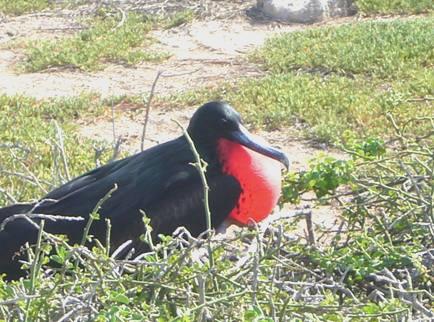
A male great frigatebird puffs up
Also on the walk we saw a turnstone, and brown noddies as well as the swallow-tailed gulls and the pelicans.
While we were waiting for the dinghy to take us back to the boat, we saw huge shoals of colourful yellow tailed grunts. After we had returned on board, frigate birds and gannets followed around our boat.
We had just time to have coffee and biscuits before it was time to disembark again. We had sailed the short distance to Baltry Island, where our plane had landed. The boat needed to get more food supplies and to refuel with diesel, so we all had to disembark. This was no hardship, as we were ferried to the nearby sandy beach, where we spent an hour or two swimming in the turquoise water and lazing on the beach. It was too hot to sunbathe, but we had sea lions to amuse us, especially when another tour leader lay down in the shade of a small boat, and the sea lions nestled up close to him, as they do to each other.
We also saw rays, gulls and pelicans. We were later back on board than anticipated, so it was now time for lunch, as we sailed on to Bachas beach onSanta Cruz Island.
Our visit to this beach was quite magical. We started by snorkelling, which wasn’t much good as the visibility was bad, but I did see a huge shoal of tiny fish. The water was such a beautiful turquoise, and the sand so beautifully white, with black lava rocks and with green vegetation behind, that just being here was a delight. The attractive ‘Spondylus’ was the only boat moored just offshore. There was another group of people on the beach, supposedly from the ‘Angelique’, the boat which is often alongside us. Apparently it had gone for some sort of repairs, and the people were ‘boatless’. Their boat luckily returned just as we were about to leave, or we might have had a crowded boat!
We enjoyed an ordinary swim – not snorkelling. The annoying thing was the horse flies, which seemed to attack wet bodies when you came out. The sun today was very hot – it was sunny all day, so we were aware of not getting burnt.
There were several lagoons behind the beach. We walked along to one, and saw a few birds – a whimbrel and ringed plovers, also one or two sanderlngs. Green turtles nest on this beach, and we could see several large hollows where they had laid their eggs, and their tracks where they went down to the sea. There were also a few small dark marine iguanas, making their tracks in the sand, looking a bit like a zip fastener – a long line, with little marks either side.
Walking along to another lagoon we came to the wreck of an old ship, with posts sticking evocatively out of the sand. We saw more birds – turnstones, blue herons, and a lava heron. There was a solitary flamingo on the lagoon but the most wonderful site was another flamingo flying overhead, its beautiful pink colour being lit up by the sun. With the background of the rock stacks Daphne Major and Minor, the whole setting was unforgettable.
We came back to the boat just as the sun was lowering in the sky.
After supper, Nadine talked to us about the geology of the islands, and informed us that we will be up at 5.00 am tomorrow!
Tuesday 30th January The joys of Genovesa Island
We had a long sail up to Genovesa Island, and it was a very bumpy ride! I wondered if I would be tossed out of bed! Nevertheless, everyone was up bright and early, and by 6 o’clock we were setting off across the wide bay, the centre of a former volcanic crater, for a walk along the lava cliffs.
We had to ascend some rough steps in the rock, called Prince Philip’s steps, after his 1965 visit, to begin the walk. The path took us through a Nazca booby nesting area, and we were able to see the parent sitting on the eggs, and one or two with chicks. The different thing to see here was the red footed boobies – as colourful as their blue footed counterparts, with their red feet and blue beaks.
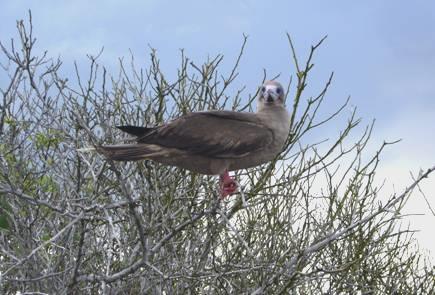
A red footed booby
It was an attractive walk over the rough lava ground (Nadine still went barefooted!) with the sea just a short distance away.
We saw one or two Galapagos doves on the ground, and crowds of Galapagos storm petrels hovering above the cliffs. Two more delights were the graceful tropicbirds with their long white tails, and the short eared owl. The latter settled quite close to us with its prey of a storm petrel, so we had a good view of him. They hunt by day, but are difficult to spot as they are so well camouflaged.
Growing from the inhospitable bare lava, the lava cactus had taken hold.
We returned to the dinghy, and back at the boat – anchored right across the bay in the only water shallow enough to drop anchor – it was a quick turnaround to change into swimming things so that we could go back and snorkel.
The water in the bay is 300ft deep. We started near the steps we had climbed up, and kept close in by the rocks. The water wasn’t very clear, but we did see lots of wonderful coloured fish, and several large shoals. Galapagos fur seals rested on the rocks, and Galapagos sea lions swam beneath us. The most exciting sighting was an enormous stingray – the largest Nadine had ever seen!
We were getting a bit cold by the time we returned to the dinghy, to be transported back to the boat.
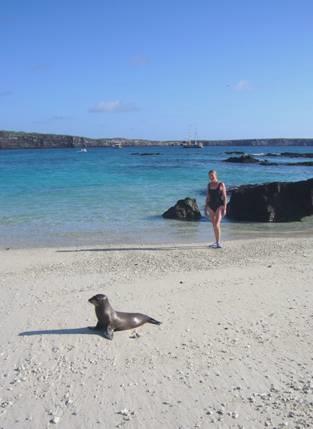
Rosie and friend Darwin Bay, Genovesa
In the afternoon we visited the beach area, where we had a lovely swim in the turquoise water. After this we set off on a trail. There had been sea lions on the beach, and there were lots of red footed boobies and Nazca boobies as we walked along past the red mangroves. Red footed boobies have prehensile webbed feet, so can cling to branches, and therefore nest in the trees. Frigate birds soared overhead, and we saw Galapagos doves, lava herons, night herons and swallow tailed gulls. The prickly pear on this island has soft spines, which you could touch.
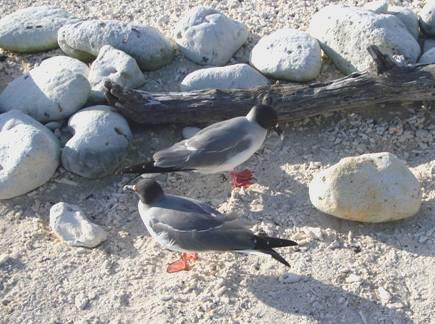
Swallowtailed gulls perform a mating dance
We waited a while on the rough lava rocks, but decided to return before sunset, as it would then be dark.
By the time we got back to the boat, it was time to get organised for supper, with another early start tomorrow, after we have sailed back to Bartolome Island.
Wednesday 31st January Our last day on board the Spondylus
Luckily the sailing was calmer than the previous night, and at 6 o’clock we were beginning the ascent to the top of the 114m crater on BartolomeIsland.

The ‘classic’ view from Bartolome
This island has very little growing on it – just a few pioneer plants, so had the appearance of a moonscape.
There were Sally lightfoot crabs to greet us as we landed, but apparently hermit crabs inhabit the whole of the crater. Also there were tiny lizards, and colourful ‘lava hoppers’ (they can’t be called grasshoppers here!)
We all made the ascent up nearly 400 steps, plus a lot of volcanic ash slopes, to the position where there was a wonderful view – we had seen it in our book. Here we stopped to have a group photo taken, minus Ron, who has been unable to go ashore since hurting his knee some days ago.

Our group on Bartolome (minus Ron)
We returned to the landing place, and then to the boat, before setting off again.
This time we landed on the beach of Bartolome, and for us it was a very wet landing – the wettest yet! Those on the second trip had a calmer sea to get out from.
The sand here was an orangey colour, but again very picturesque, with the huge pinnacle rock jutting up, and volcanic rock scenery all around. We walked across the narrow isthmus to the beach on the other side, climbing up and across the sand dunes, and through the mangroves.
On the other beach ghost crabs scuttled away from us, and we saw a small marine iguana and the 2 herons we had seen from the top of the crater. A group of Galapagos penguins were frolicking in the sea. The colouring of the dunes against the blue sky was wonderful, and made a nice picture with turtle tracks leading across the sand.
Back on the northern beach we set off to snorkel around the rocks. It was a long way out to the rocks, and the water was very murky, but we still had some good sightings – lots of fish, including several large shoals; white needled sea urchins; and I saw 2 large starfish. Sea lions swam swiftly under and around us, taking us by surprise.
The swim back across the bay seemed even longer, but we still went back into the water for our last swim, before returning to the boat for an early lunch.
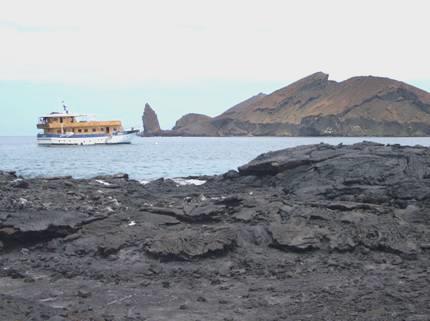
Looking to Spondylus and Bartolome from Sullivan Bay, Santiago
After this we sailed the short distance to Santiago Island, where we alighted at Sullivan Bay. This was to walk on the black ropy lava from the last lava flow a hundred years ago. The lava felt very hot (from the sun), and was contorted into all sorts of weird and wonderful shapes. Back on the boat, we sailed at 1.45 for Puerto Ayora for our last night on the boat.
We were all sitting on deck when the captain sounded the horn loudly. We jumped up and saw a whole group of dolphins and one orca whale cavorting all around us. It was a wonderful sight.
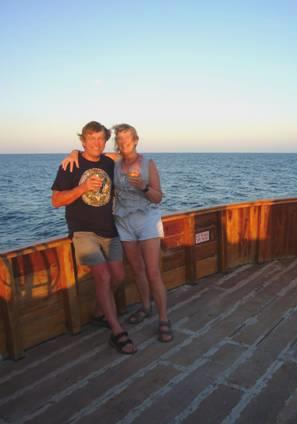
Enjoying full moon on deck
We enjoyed going through the channel between Baltra and Santa Cruz islands before sailing down the eastern side of Santa Cruz to Puerto Ayora.
We had our last supper on board, having supped wine on deck while sitting with all the others. Doug did a speech in Spanish to thank the crew, and we handed over our tips to them and to Nadine. The crew had been excellent, and we’d had a very happy time on board, with excellent food.
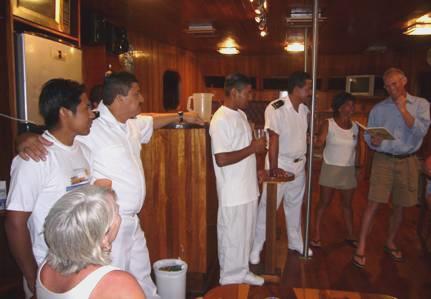
Doug says thanks to the crew
We docked at 8.30 pm, and a group of us took the dinghy to have a look around the town. It seemed a normal, happy place. Some gift shops were still open, so after a little look around, we joined the others at a bar, before coming back to the boat at 10 o’clock for our last night on board.
Thursday 1st February We fly back to Guayaquil
We were up at 5.30 to have breakfast and leave the boat at 7.00 am. We had our last dinghy trip to the dock, calling out goodbye to Edwin the ‘steerer’. The sun was already very hot.
We took taxis to visit the Charles Darwin Research Centre. It was still a long walk into the centre, and then a lot of walking around as we saw various giant tortoises.
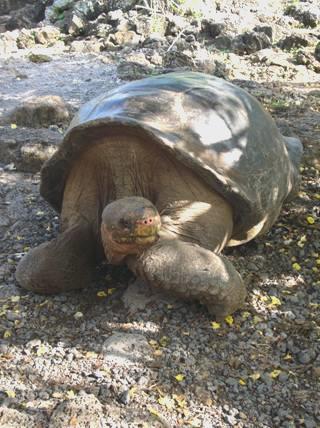
A Galapagos giant tortoise
Tortoises are hatched and raised at the centre until they can safely be returned to their various islands. We saw dozens of baby tortoises looking a bit like a load of woodlice. Tortoises vary in their shape on the different islands. We saw ‘Lonesome George’, the last of the Pinta Island subspecies.
From here we got on the bus which took us back across Santa Cruz island to the Baltra Channel. Then it was the short ferry ride followed by the short bus journey to the airport.
Now it was time to say goodbye to Nadine, our bubbly and informative guide, before boarding the plane which left at 12.15 for Guayaquil. It was 3 o’clock local time when we reached Guayaquil (one hour on).
We were met by Rocia, the tour representative, and taken by bus back to Quil Hotel, where we settled back into our previous room. We had used the internet, and read messages from our children.
In the evening we all went for our last meal together at Lo Nuestra restaurant, where a pleasant and convivial time was had. We really have had an excellent and nice group for our trip.
Friday 2nd February Our last day in Ecuador – a day in Guayaquil
It was different not to have an alarm to wake up to! We all breakfasted at about 8 o’clock, and then left to explore some of Guayaquil. We took a taxi with Clive and Diana, and spent the rest of the morning walking around with them. Diego had told us of the recently refashioned waterfront area of this previously dirty and dangerous town. We were hugely impressed by what we saw. There is a promenade along the waterfront called ‘Malecon 2000’ for 2½ km, with gardens and recreation facilities.
We began by ascending the hill called Santa Ana - over 400 steps past brightly coloured houses to the lighthouse at the top. There were armed police every little way, who greeted us as we passed. From the top we had views down over the city – still misty at this time, but it soon became very warm.
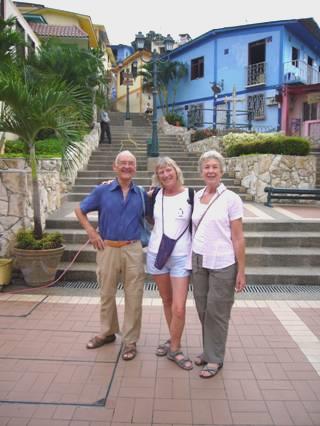
About to ascend Santa Ana
We then began our walk along the front, diverting into some beautifully well kept gardens, where most of the trees were labelled. People were at work everywhere, watering, tidying and cleaning.
We stopped to have a late coffee at an outdoor restaurant overlooking the water, and were joined by Ron and Diana, who said that the rest of the group were meeting there at 2 o’clock for lunch. Unknown to us, this was a restaurant which Rocia had recommended yesterday.
We walked right along to the other end of the promenade, passing various monuments, and the attractive clock tower. We now walked back through a busy and endless market, with stalls selling watches, radios, mobile phones, sportswear and other non-essentials. It was a vibrant and busy place.

The cathedral, Guayaquil
A few blocks inland we came to the fine cathedral, and a small park which land iguanas have made their home. By now it was time to meet the others for lunch – there were 12 of us, as Mary had left early this morning, and Carol and Doug and Barry were elsewhere. We both had shrimp soup, which was excellent, with a beer. It was nice to share a last lunch together.
We now left to wander the streets a bit more, finally ending up at the artisan market, where I bought a last T-shirt. We had trouble in getting a taxi back – taxi drivers don’t seem to know where the hotel is. The one who eventually took us, drove first to the wrong hotel, in the centre of town, so had gone a long way out of his way.
By 5.45, Ron, Diana and Gill had not returned, despite their taxi leaving at 4.45, when Roger and Janet’s did. A very anxious time followed – until they arrived just before 6 o’clock – it had taken them 3 different taxis to finally find the hotel! There was a mad scramble while they quickly showered – using our room – I gave up on asking the hotel staff for a clean towel, as there was so much confusion.
All was well for them, as they left on their coach for the airport, with Rocia.
We said our goodbyes once again, and waved them all off, while we prepared for our last night in Ecuador.
We asked the hotel under-manager about where to eat tonight, and he suggested ‘Little Malecon’, which was nowhere near the other promenade - ‘Malecon 2000’, but was still on the river. We took a taxi there, and joined the milling crowds on a Friday night – well, not milling, but quite a lot!
There were eating places set along beside the walkway – fast food looking, but with outside seating, and what turned out to be a sort of karaoke, with variable singing talents! We ate prawns and fish, with a large jug of beer, and took in the atmosphere. There was a pretty blue bridge nearby, all lit up.
When it was time to come back, we called a taxi, and jumped into a very battered vehicle, with little hope of returning successfully to our hotel, but the chap drove us straight there! In the foyer we chatted to Doug and Carol, and shared our tales of today’s exploits.
Saturday 3rd –Sunday 4th February Home!
It was strange to eat breakfast on our own! Carol and Doug came in to say goodbye – they were off by bus to visit Cuenca, and we would like to have joined them!
We chatted to the under-manager again, who said that he had lived in England for 10 years, and had a daughter living in London. He asked us to exchange the 10 pound coins that he had for dollars, which we did - we had wondered what he was going to ask when he said that he had a favour to ask – we thought that he was going to ask us to take a package for him!
We took a taxi for the short way to the airport, and went on through for our 11.20 flight to Heathrow, via Miami. During our flight we could look down on to several coral atolls, and flew over what would appear to be Cuba.
We watched the film entitled ‘The Queen’, about the feelings and relationships between the Queen and Tony Blair after the death of Princess Diana. I found it very moving to watch scenes of these emotive times again.
In Miami we went through all the various formalities, including collecting and re-registering our baggage. We heard of the big storm which had just struck Florida.
We were pleased to arrive just in time for our flight to Heathrow, but had to hang around a while on the runway because of a problem of the previous plane having broken down at take off.
Once in the air, things went well. We watched a film called ‘A good year’, about a chap returning to live in the place in France where he had spent his summers as a boy. After that we slept a bit, and woke to see the lights as we flew up over Cornwall and Devon, but as we reached Heathrow, we began circling, so lost all the time which we had gained over the Atlantic. We flew in right over Windsor Castle.
We arrived at Heathrow at 7 o’clock local time, but the luggage took ages to get to the carousel. When it finally arrived, we had only one of the 3 bags we had checked in! More hanging around, as we waited to fill in forms – 3 times on our last 3 trips that this has happened!
We had no phone, no house keys and no jacket! We had missed our National Express bus (and the next one)! When we got to the National Express counter (all the moving walkways on the way there were out of action) there was an enormous queue. When it finally came to our turn, we found out that all their computers were down, so they couldn’t change or issue any tickets. Instead they booked us onto a Railair bus to Reading Station, and refunded our money.
We went out into the cold February morning – the sky was blue, but there was frost on the ground, and we had been in temperatures of 30+ for 3 weeks! As I chatted to a lady from South Africa, we waited for our bus, but it had come in to a different bay from the one we were told, and we just saw it leave!
We pondered what to do, but went in and found a public phone and rang Hil, who agreed to come and collect us at Reading and take us to Hermitage.
We caught the 9.40 bus, and by 10.10 were at Reading Station. We had to wait a little while for Hil, but by late morning we were back home. We had had a really great time.
The Galapagos Islands









